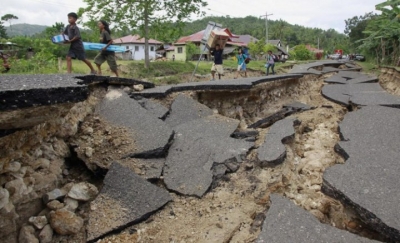 Soaps are salts of fatty acids. Common soaps are water soluble sodium and potassium salts of fatty acids. Soap cannot form lather unless it dissolves in water. Hard water does not dissolve soap because the calcium and magnesium salts present in it produce insoluble substances by reacting with soap. These insoluble substances separate out as scum and reduce the effectiveness of the soap as a cleansing agent.
Soaps are salts of fatty acids. Common soaps are water soluble sodium and potassium salts of fatty acids. Soap cannot form lather unless it dissolves in water. Hard water does not dissolve soap because the calcium and magnesium salts present in it produce insoluble substances by reacting with soap. These insoluble substances separate out as scum and reduce the effectiveness of the soap as a cleansing agent.
Category Physics
Why do stars twinkle?

Stars are giant glowing balls of fire situated far away from us. Many of them are several times larger than our sun, but being very far away, appear as points of light. Stars themselves don’t twinkle but appear as steady points of light when seen from space where there is no atmosphere. The twinkling of stars as seen from ground is caused by the unsteadiness of the Earth’s atmosphere. When light from an extended source such as the Sun, Moon or the planets pass through the atmosphere, it does not appear to twinkle because the slight changes in apparent brightness in one part is usually compensated by light coming from another part of the celestial object. But when light from a point source like a distant star passes through the atmosphere the fluctuations in the light intensity is not compensated and the star appears to twinkle.
Why do earthquakes occur?

According to the plate tectonics theory, the Earth’s surface consists of huge, rocky plates that move slowly past one another. Known as tectonic plates, some of these carry continents, others the ocean floors and some a combination of the two. Most earthquakes take place along the boundary between two plates. Propelled by heat-driven currents in the softer rock beneath them, the plates constantly pull apart, collide, or grind against each other. When the strain becomes too great, the pent-up energy ruptures the rocks and creates a fracture known as a fault. This sudden release of energy unleashes the ground-shaking vibrations that constitute an earthquake.
Why is the sky blue?
 The sky as seen from the Earth appears blue because of the scattering of sunlight by the Earth’s atmosphere. When sunlight reaches the Earth’s atmosphere, it hits suspended molecules of air and dust and gets scattered in all directions. Sunlight consists of light waves of varying wavelengths each of which is seen as a different colour. The size of the scattering molecules decides which colour is scattered most. Gas molecules in the atmosphere scatter blue colour the most. So during the day the sky appears blue because more blue light is deflected towards the earth. However, on the Moon, since there is no atmosphere, scattering of sunlight is negligible. So the sky appears black from the Moon.
The sky as seen from the Earth appears blue because of the scattering of sunlight by the Earth’s atmosphere. When sunlight reaches the Earth’s atmosphere, it hits suspended molecules of air and dust and gets scattered in all directions. Sunlight consists of light waves of varying wavelengths each of which is seen as a different colour. The size of the scattering molecules decides which colour is scattered most. Gas molecules in the atmosphere scatter blue colour the most. So during the day the sky appears blue because more blue light is deflected towards the earth. However, on the Moon, since there is no atmosphere, scattering of sunlight is negligible. So the sky appears black from the Moon.
Why there are no tides in lakes?
 The tides are caused by the gravitational pull of the Moon on Earth’s oceans. In fact, the Moon’s gravitational pull attracts everything, even the land and mountains, though being rigid and fixed they do not move. But not so with the oceans. Being an unbroken stretch of water, spread over almost 70% of the Earth’s surface, the Moon’s pull can easily draw water away from one part and pile it up at another which show up as tides. However, this is not possible in a small body of water such as a lake. Here the total surface area and volume of water is too small to produce any perceptible change in the level as happens in tides.
The tides are caused by the gravitational pull of the Moon on Earth’s oceans. In fact, the Moon’s gravitational pull attracts everything, even the land and mountains, though being rigid and fixed they do not move. But not so with the oceans. Being an unbroken stretch of water, spread over almost 70% of the Earth’s surface, the Moon’s pull can easily draw water away from one part and pile it up at another which show up as tides. However, this is not possible in a small body of water such as a lake. Here the total surface area and volume of water is too small to produce any perceptible change in the level as happens in tides.
Why does fog occur?

Fog is a collection of tiny water droplets that float in the air near the ground. When there is a sudden fall in temperature, moisture present in the air condenses and begins to change into tiny droplets of water. The air holds these droplets as fog as long as the temperature remains low. But when the air temperature rises, the tiny droplets evaporate and the fog disappears.

